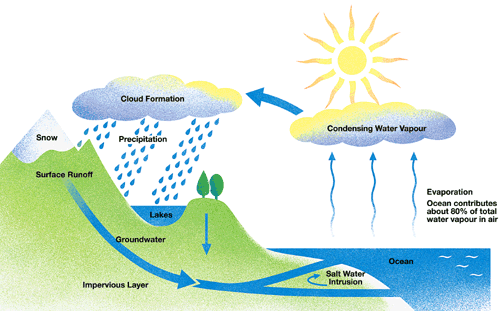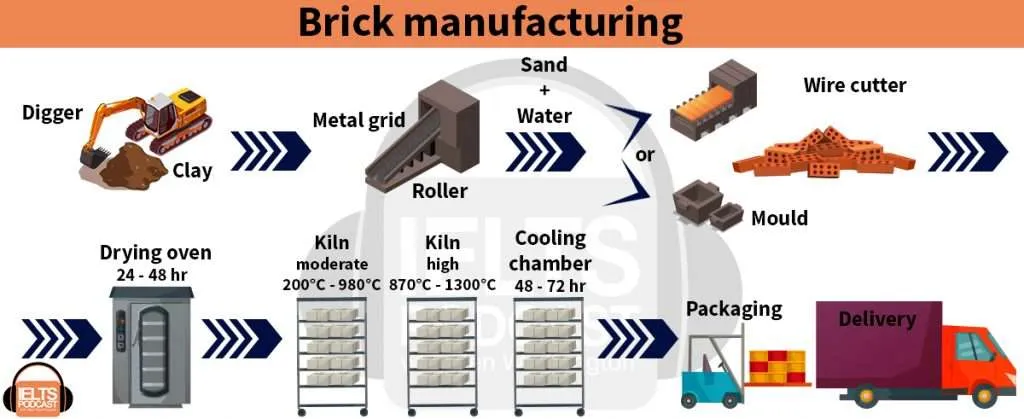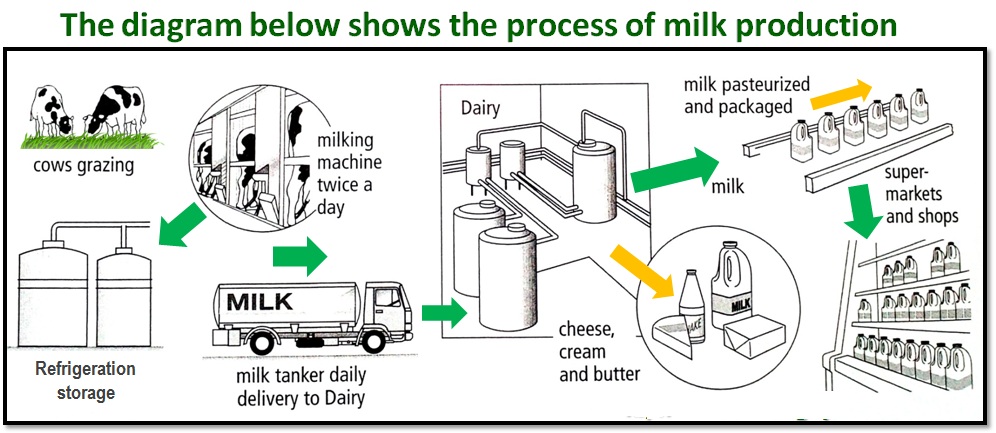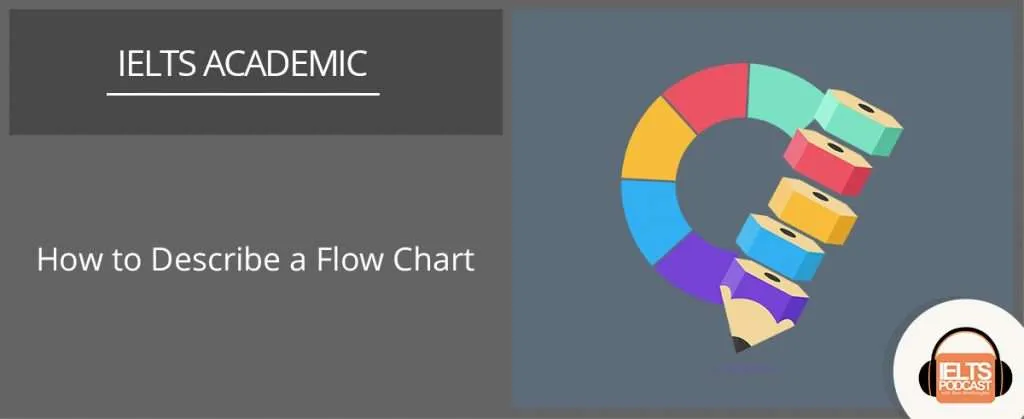How to describe a flow chart in IELTS
Home »
IELTS academic task 1 »
How to describe a flow chart in IELTS
In this tutorial you will:
- understand how to identify the main features of a flowchart
- review how to write about a flowchart (a description and analysis of a process)
- learn how to divide the writing task into three main parts
This will help you to:
- approach this type of task with confidence
- obtain a high IELTS score in this exam task
*Note that flow chart and flowchart can be used interchangeably.
What is a flow chart?
So, what is a flowchart? A flowchart is a picture of a process, for example, the water cycle or a diagram of the process of manufacturing an item. A flowchart can be simple or complex. Instead of just a written description of a process, a flowchart is a tool that makes it easier to understand the process and visualise it. A flowchart is usually fairly simple but make sure, if it is a process that's linear you can clearly see the beginning and the end. It can be used to create a better understanding of a process.
It's important to look at flowchart examples to practice identifying the main features.
Here's an example of a cyclical process (it has no clear beginning and end, as the process keeps repeating)

The task 1 flow chart
What is a flowchart going to be like in the IELTS test?
An IELTS
academic writing task 1 may ask you to summarise and report on a flow diagram describing a process.
Flow chart (also known as a flow diagram, a process map, a process flow diagram, data flow diagram or a flowchart) questions may not be as common in IELTS exams as pie charts or line graphs but that does not mean you won't have one when you take the test.
Let's look at the steps you should follow to answer a flowchart question and make sure you get a high score in this test activity.
Look before you plan
A task 1 flow chart might look like this:
You should spend about 20 minutes on this task.
The diagram below shows how bricks are manufactured.
Summarise the information by selecting and reporting the main features, and make comparisons where relevant.
Write at least 150 words.

I'm sure all of us have looked at a diagram of how to do something, from making a Lego model to setting up an electronic device. This is actually a flowchart. What we do is spend a while just looking at it, working out the steps on the flowchart and the connections between them. Here we should do the same. Ask yourself key questions:-
- How many steps are there?
- Are there points in the process when there are two things occurring simultaneously or where there are alternatives?
- Are there any cause-effect relationships in the diagram?
Plan before you write
IELTS writing task 1 is assessed according to 4 criteria:
When you plan what to write and how to organise it, think about what the examiner is looking for. To score at least a 7.0 or higher in task achievement for a flowchart question on the exam you must simply do what you are told and include in your summary all the main relevant details. Remember that when describing a process students are to practice using the passive voice, not the active voice grammatical structure.
Describing a process may in fact be easier than seeing and describing the relevant information in pie charts or line graphs. You should also include what they call a "clear overview", a sentence which captures the main significance of the data presented.
So, the structure of the report could look like this:
- Introduction: 2 sentences, the first to generally state what the process is and the second to point out some comments on the process, its relevance, complexity and so on.
- Main body: a sequential description of the process itself. In our examples, how many stages did you count? Would we need one sentence for each stage or is it possible to combine some together in complex sentences?
- A short conclusion of one or two sentences: We may decide in fact to include the "overview" here instead of at the beginning as some kind of concluding remark.
The writing process
Let's now think about the other three criteria. A report needs to make sense to the reader, the details placed in a logical sequence or natural process and appropriate links made to show relationships such as time, cause and consequence for example, as well as the effective division of the whole into paragraphs. In other words, a flow chart shows coherence and cohesion.
We can also refer to a process diagram if required. The diagram illustrates and illuminates hard data into a visual representation such as a pie chart and graph diagrams.
In a description of a series of steps in a word process we can use the these flow chart vocabulary, linking words -
first, secondly, then, after that, the next ...., finally - to stress the sequential nature of the process as well as connectors such as -
while, concurrently, at the same time - may also be useful if two process occur simultaneously.
There may also be choices, marked by -
either ...or, alternatively, can ...also. Looking at our diagram, there are two occasions when there are choices.
For the IELTS writing tasks, candidates are always encouraged to show a wide range of
vocabulary and wherever possible and appropriate to use less common items as well as demonstrate a wide grammatical range. When describing a process, it is also important not to simply repeat information already contained in the data given. In other words, the ability to use synonyms, to show grammatically correct lexical variety is one way to achieve a
high score.
For example, synonyms for "show". How many can you think of?
Show, illustrate, depict, and
demonstrate come to mind. Our opening sentences for example could read:
The diagram illustrates the main method by which bricks are made. This is a man-made process. What is striking about the process is its simplicity, depending as it does essentially on just three raw materials, namely, clay, sand and water.
In this sample answer on a process, we have
illustrated instead of
shown, the process is
striking, though it could have been
remarkable or
noticeable/noteworthy. We have also given some kind of overview.
Descriptions of processes are also characterised by the predominance of the passive voice in the present tense. What we often call "objective" scientific style writing is associated with this feature in English. In simple terms, we have no interest whatsoever in the people involved, just the process itself. In contrast, using simple present tense focuses more on the person doing the action, not the process or action.
Look through the steps, how many verbs do we need for the description and how many be used in the passive. Variety is so important. Also try to use where appropriate verbs often used to describe processes in general, such as
do - done; carry out - carried out. Spend time studying this grammatical feature as part of your
IELTS preparation.
Some useful examples of the passive:
The process is completed when...
The completed items are checked
The boxes are labelled
The boxes are loaded onto a truck
They are distributed
Water is added
Heat is applied
A mixture is created
We could begin the main part:
The diagram illustrates the brick-making process. This report on the manufacture of bricks on an industrial scale shows that this linear process consists of eight main steps from extraction of the raw material to final delivery. The first few stages involve combining the raw materials to make bricks, then the next stages involve using heat to harden the bricks.
In the first step, the principal raw material out of which bricks are made, clay, is extracted from the earth using a mechanical digger. Large lumps of clay are then reduced in size by being placed on metal grids and passed over a series of rollers. In the subsequent stage, sand and water are added in order to help solidify the clay.
In this example you will have re-phrased the question and provided an overview. An easy way to do that for a process diagram is to say how many steps there are and mention the first and last step. You should also say whether it is a linear process, with a beginning and an end, or cyclical. Natural processes, like the life cycle of a frog, tend to be cyclical. Then, try to find some common elements (the first few stages involve mixing the materials, the next few involve heat).
Notice also the level of sentence complexity in the sample answer. The examiner is looking for a mixture of grammatical structures and sentences which are error free.
After writing
You only have 20 minutes to complete this task. We've mentioned looking and planning followed by writing. However, it is also very important that you spend some time after writing, checking things over. Here is a possible time frame:
- 3-5 minutes: Reading question, looking and planning
- 10-12 minutes: Writing
- 3-5 minutes: Checking
Checking means looking out for any "silly" mistakes in spelling, grammar, vocabulary, punctuation. You would be surprised how many avoidable mistakes occur under exam pressure. Mistakes like the concordance between singular or plural nouns and their corresponding verb forms, for example.
Also, make sure that you have correctly used articles
a, an, the throughout the essay.
Try this by yourself:
Remember, it's important to look at as many flowchart examples as possible as a way to prepare fully.
Use the example above to plan and to create an answer to the question below.
Then check, have you included all the important elements?
You should spend about 20 minutes on this task.
The diagram below shows how bricks are manufactured.
Summarise the information by selecting and reporting the main features, and make comparisons where relevant.
Write at least 150 words.

Audio tutorial
You can download or listen to the audio version here:
|
Direct Download Here |
Stitcher |
iTunes |
Spotify |
Soundcloud |
Transcript |
Here are some extra task 1 examples to help you:
Sample task 1 questions and essays


 I'm sure all of us have looked at a diagram of how to do something, from making a Lego model to setting up an electronic device. This is actually a flowchart. What we do is spend a while just looking at it, working out the steps on the flowchart and the connections between them. Here we should do the same. Ask yourself key questions:-
I'm sure all of us have looked at a diagram of how to do something, from making a Lego model to setting up an electronic device. This is actually a flowchart. What we do is spend a while just looking at it, working out the steps on the flowchart and the connections between them. Here we should do the same. Ask yourself key questions:-

